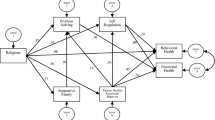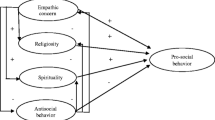Abstract
Recent research has suggested that religion may play an important role in determining mental health. Although research has examined the effects of religiosity on specific types of psychopathology, less research has examined psychopathology broadly in the context of particular aspects of religion. Thus, the current study examined intrinsic and extrinsic religiosity and a range of psychopathology in 486 emerging adult college students. Results of a MANOVA indicated a main effect for intrinsic religiosity on a range of psychopathology and an interaction effect between intrinsic and extrinsic religiosity on antisocial personality problems. Implications and limitations of the current study are discussed.

Similar content being viewed by others
References
Allport, G., & Ross, J. (1967). Personal religious orientation and prejudice. Journal of Personality and Social Psychology, 5(4), 432–443.
Batson, C. D., Schoenrade, P., & Ventis, W. L. (1993). Religion and the individual: A social-psychological perspective. New York: Oxford University Press.
Belzen, J. A. (2000). Aspects in context: Studies in the history of psychology of religion. Amsterdam: Rodopi.
Bergin, A. (1983). Religiosity and mental health: A critical re-evaluation and meta-analysis. Professional Psychology: Research and Practice, 14, 170–184.
Bingaman, K. A. (2010). A pastoral theological approach to the new anxiety. Pastoral Psychology, 59(6), 659–670. doi:10.1007/s11089-009-0269-8.
Cohen, J. (1988). Statistical power analysis for the behavioral sciences (2nd ed.). Hillsdale, NJ: Erlbaum.
Cole, A. R. (2000). A spirit in need of rest: Luther’s melancholia, obsessive-compulsive disorder, and religiosity. Pastoral Psychology, 48(3), 169–190.
Gorsuch, R. L., & McPherson, S. E. (1989). Intrinsic/extrinsic measurement: I/E revised and single-items scales. Journal for the Scientific Study of Religion, 28(3), 348–354.
Hackney, C. H., & Sanders, G. S. (2003). Religiosity and mental health: A meta-analysis of recent studies. Journal for the Scientific Study of Religion, 42(1), 43–55.
Hill, P. C., & Pargament, K. I. (2003). Advances in the conceptualization and measurement of religion and spirituality: Implications for physical and mental health research. American Psychologist, 58, 64–74.
Huguelet, P., Borras, L., Gillieron, C., Brant, P.-Y., & Mohr, S. (2009). Influence of spirituality and religiousness on substance misuse in patients with schizophrenia and schizo-affective disorder. Substance Use and Misuse, 44, 502–513.
Klanjšek, R., Vazsonyi, A. T., & Trejos-Castillo, E. (2012). Religious orientation, low self-control, and deviance: Muslims, Catholics, Eastern Orthodox-, and “Bible Belt” Christians. Journal of Adolescence, 35(3), 671–682.
Koenig, H. G., Zaben, F., & Khalifa, D. (2012). Religion, spirituality and mental health in the West and the Middle East. Asian Journal of Psychiatry, 5(2), 180–182.
Larson, D. B., Kimberly, A. S., Lyons, J. S., Craigie, F. C., Thielman, S. B., Greenworld, M. A., et al. (1992). Associations between dimensions of religious commitment and mental health reported in the American Journal of Psychiatry and Archives of General Psychiatry 1978–1989. American Journal of Psychiatry, 149, 557–559.
Leach, M. M., Berman, M. E., & Eubanks, L. (2008). Religious activities, religious orientation, and aggressive behavior. Journal for the Scientific Study of Religion, 47(2), 311–319.
Lindenthal, J. J., Myers, J. K., Pepper, M. P., & Stern, M. S. (1970). Mental status and religious behavior. Scientific Study of Religion, 9, 143–149.
Longest, K. C., & Smith, C. (2011). Conflicting or compatible: Beliefs about religion and science among emerging adults in the United States. Sociological Forum, 26(4), 846–869.
Maltby, J., & Day, L. (2002). Religious experience, religious orientation and schizotypy. Mental Health, Religion, and Culture, 5, 163–174.
Merrill, R. M., Steffen, P., & Hunter, B. D. (2012). A comparison of religious orientation and health between Whites and Hispanics. Journal of Religion and Health, 51(4), 1261–1277. doi:10.1007/s10943-010-9432-x.
Paloutzian, R. F., & Park, C. L. (Eds.). (2005). Handbook of the psychology of religion and spirituality. New York: The Guilford Press.
Pfeifer, S., & Waelty, U. (1999). Anxiety, depression, and religiosity—a controlled clinical study. Mental Health, Religion, and Culture, 2, 35–45.
Plante, T. G., & Sherman, A. C. (Eds.). (2001). Faith and health: Psychological perspectives. New York: Guilford Press.
Rescorla, L., & Achenbach, T. (2004). The Achenbach System of Empirically Based Assessment (ASEBA) for ages 18 to 90 years. In M. E. Maruish (Ed.), The use of psychological testing for treatment planning and outcomes assessment, Volume 3: Instruments for adults (3rd ed., pp. 115–152). Mahwah, NJ: Lawrence Erlbaum Associates Publishers.
Salsman, J. M., & Carlson, C. R. (2005). Religious orientation, mature faith, and psychological distress: Elements of positive and negative associations. Journal for the Scientific Study of Religion, 44(2), 201–209.
Tix, A. P., & Frazier, P. A. (1998). The use of religious coping during stressful life events: Main effects, moderation, and mediation. Journal of Consulting and Clinical Psychology, 66, 411–422.
Weisman de Mamani, A., Tuchman, N., & Duarte, E. A. (2010). Incorporating religion/spirituality into treatment for serious mental illness. Cognitive and Behavioral Practice, 17(4), 348–357.
White, J., Joseph, S., & Neil, A. (1995). Religiosity, psychoticism, and schizotypal traits. Personality and Individual Differences, 19, 847–851.
Author information
Authors and Affiliations
Corresponding author
Rights and permissions
About this article
Cite this article
Power, L., McKinney, C. The Effects of Religiosity on Psychopathology in Emerging Adults: Intrinsic Versus Extrinsic Religiosity . J Relig Health 53, 1529–1538 (2014). https://doi.org/10.1007/s10943-013-9744-8
Published:
Issue Date:
DOI: https://doi.org/10.1007/s10943-013-9744-8




